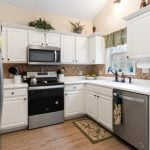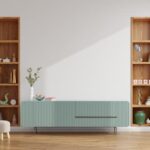Are you wondering how to decorate a bi-level home and make the most of its unique layout? Bi-level homes, also known as split-level homes, offer distinct design challenges and opportunities. Understanding the layout of a bi-level home is crucial in creating a cohesive and stylish living space that maximizes functionality and aesthetic appeal.
One of the key aspects of decorating a bi-level home is understanding the different levels and how they flow together. From choosing the right color scheme to furniture placement and maximizing natural light, there are various considerations to keep in mind when designing a bi-level home. In this article, we’ll explore practical tips and creative ideas for decorating and styling a bi-level home to create a seamless and inviting living environment.
From choosing the right color scheme to selecting furniture that complements the unique layout, decorating a bi-level home requires thoughtful planning and execution. With the right strategies, it’s possible to enhance the visual appeal of each level while ensuring that the overall design flows seamlessly throughout the entire space.
Whether you’re looking to maximize storage or incorporate personal touches, we’ll provide expert advice on how to elevate your bi-level home’s aesthetic while optimizing its functionality.
Making the Most of the Split-Level Space
Bi-level homes are known for their unique split-level layout, which can present both challenges and opportunities when it comes to interior design and decor. One of the key aspects to consider when decorating a bi-level home is how to effectively utilize the different levels to create a cohesive and functional living space.
When it comes to making the most of the split-level space in a bi-level home, it’s important to take advantage of the distinct areas while ensuring a seamless flow between them. This can be achieved by using design elements such as color schemes, flooring materials, and lighting that tie the different levels together. Additionally, utilizing furniture and decor that complement each other across levels can help create a harmonious look throughout the home.
In addition to creating a cohesive design flow, it’s also essential to maximize the functionality of each level in a bi-level home. This may involve strategically placing furniture to define separate living areas within an open floor plan or incorporating built-in storage solutions to make use of underutilized spaces.
With creativity and thoughtful planning, homeowners can transform the split-level layout into an inviting and well-designed living environment that makes the most of its unique architectural features.
| Area | Suggestion |
|---|---|
| Furniture Placement | Define separate living areas within an open floor plan by strategic placement. |
| Storage Solutions | Incorporate built-in storage solutions in underutilized spaces. |
Choosing the Right Color Scheme for a Bi-Level Home
When it comes to decorating a bi-level home, choosing the right color scheme is crucial in creating a cohesive and visually appealing look. Due to the unique layout of a bi-level home, it’s important to carefully consider how different colors will work within the space.
One of the key factors to keep in mind when selecting a color scheme for a bi-level home is to create a sense of flow between the different levels. This can be achieved by using a consistent color palette throughout the house, while incorporating different accents and shades to add visual interest.
In general, light and neutral colors work well in smaller spaces, especially in lower levels with less natural light. They can help create an open and airy feel, making the rooms appear larger than they actually are. Additionally, using lighter hues can also help bounce natural light around the space, brightening up darker areas. On the other hand, utilizing darker or bolder colors in certain areas can add depth and drama to specific spaces within the home.
| Key Considerations for Choosing Color Schemes | Tips for Incorporating Different Hues |
|---|---|
| Create flow between levels with consistent palette | Use lighter hues in smaller spaces for an open feel |
| Utilize accents and shades for visual interest | Introduce darker or bolder colors for depth and drama |
Furniture Placement and Arrangement Tips
When it comes to decorating a bi-level home, one of the key considerations is how to effectively place and arrange furniture to make the most of the split-level space. With different levels and often unique layouts, it can be a challenge to create a cohesive and functional living environment. Here are some tips for furniture placement and arrangement in a bi-level home:
- Take advantage of the distinct areas: Use the different levels of your bi-level home to create separate living spaces. For example, the lower level can be designated as a cozy family room or entertainment area, while the upper level can serve as the main living room or dining area.
- Consider the flow of traffic: Ensure that there is a clear and unobstructed path between rooms and levels. Arrange furniture in a way that allows for easy movement throughout the space.
- Scale appropriately: Pay attention to the scale of your furniture in relation to the size of each room. Avoid overcrowding or choosing pieces that are too large for the space.
In addition to these tips, it’s important to also consider how to decorate vertical elements such as staircases and open spaces between levels. Utilize wall space with shelves or artwork to add visual interest, and incorporate rugs or lighting fixtures to define specific areas within each level.
By carefully considering these furniture placement and arrangement tips, you can enhance the functionality and aesthetic appeal of your bi-level home while creating a comfortable and inviting atmosphere for you and your family.
Maximizing Natural Light in a Bi-Level Home
When it comes to maximizing natural light in a bi-level home, there are several strategies you can implement to make the most of the split-level space. One of the first things to consider is the placement of windows and doors. Adding larger windows or even installing skylights can bring in more natural light, especially in areas that may feel darker or more enclosed.
Another important factor in maximizing natural light is choosing the right window treatments. Opt for sheer curtains or blinds that allow light to pass through while still providing some privacy. Avoid heavy drapes or dark-colored window coverings, as these can block out precious sunlight.
In addition to window treatments, using reflective surfaces such as mirrors or glass furniture can help bounce light around the space and make it feel brighter and more open. Consider incorporating reflective elements into your decor to enhance the natural light in your bi-level home.
By implementing these strategies, you can create a bright and airy atmosphere in your bi-level home that makes the most of its unique layout. With thoughtful consideration of window placement, choice of window treatments, and use of reflective surfaces, you can enhance the natural light in your space and make it feel welcoming and inviting.
Incorporating Functional and Stylish Storage Solutions
When decorating a bi-level home, it’s essential to make the most of the space available, and one way to achieve this is by incorporating functional and stylish storage solutions. Whether you’re dealing with a small entryway, limited closet space, or awkward corners, there are several creative ways to maximize storage in a bi-level home.
Here are some ideas for incorporating functional and stylish storage solutions into your bi-level home:
- Utilize under-the-stair storage: The area underneath the stairs is often overlooked, but it can be a prime spot for creating extra storage. Consider installing built-in cabinets, shelves, or drawers to make use of this typically wasted space.
- Opt for multipurpose furniture: In rooms with limited space, such as the living room or bedrooms, look for furniture pieces that can serve dual purposes. For example, ottomans with hidden storage, coffee tables with built-in shelves or drawers, and beds with under-bed storage can all help to maximize space while adding style to your home.
- Embrace vertical space: Take advantage of wall-mounted shelves, hooks, and organizers to free up floor space and keep clutter at bay. This is particularly helpful in areas like the kitchen, where vertical storage can help to keep countertops clear and organized.
Ultimately, when it comes to decorating a bi-level home with functional and stylish storage solutions, it’s important to think outside the box and get creative with your approach. By utilizing underutilized spaces, choosing versatile furniture pieces, and embracing vertical storage options, you can effectively declutter your home while maintaining a cohesive design aesthetic.
Creating a Cohesive Design Flow Between Levels
When it comes to decorating a bi-level home, creating a cohesive design flow between the different levels is essential for a harmonious and visually appealing space. With careful planning and strategic decorating, you can ensure that the transition from one level to another feels seamless and integrated. Here’s how to achieve a cohesive design flow in your bi-level home.
Consistent Color Palette
One of the key elements in creating a cohesive design flow between levels is to use a consistent color palette throughout the home. This doesn’t mean that every room needs to be painted the same color, but rather that there should be a sense of harmony and coordination between the colors used on each level. Consider using variations of the same color family or introducing complementary hues to tie the different areas together.
Continuity in Flooring
Another important aspect of achieving a cohesive design flow is maintaining continuity in flooring materials between the various levels of your bi-level home. Whether you opt for hardwood, laminate, tile, or carpet, selecting one type of flooring or coordinating complementary materials will help create a seamless transition as you move from one level to another.
Unified Decor Elements
In addition to color and flooring, unifying decor elements such as artwork, textiles, and accessories can contribute to a cohesive design flow in your bi-level home. By incorporating similar styles of decor and repeating certain motifs or patterns throughout both levels, you can establish a sense of visual connection and coherence.
By implementing these strategies for creating a cohesive design flow between levels in your bi-level home, you can enhance the overall aesthetic appeal of your living space while also ensuring that each area feels interconnected and well-integrated.
Adding Personal Touches and Décor Accents to Enhance the Bi-Level Aesthetic
Personalizing a bi-level home is an essential part of making it feel like a warm and inviting space. Since bi-level homes can sometimes feel disjointed due to the split-level layout, adding personal touches and dcor accents can help enhance the overall aesthetic and create a cohesive look throughout the different levels.
Custom Artwork and Family Photos
One way to add a personal touch to a bi-level home is by incorporating custom artwork and family photos throughout the space. Consider creating a gallery wall on the staircase or in the main living area to showcase meaningful photographs, artwork, or even personalized signage that reflects your family’s personality and style. This not only adds visual interest but also makes the space feel more personalized and lived-in.
Layered Textiles and Soft Furnishings
Incorporating layered textiles such as rugs, throw blankets, and accent pillows can add warmth and coziness to a bi-level home. Consider choosing soft furnishings in colors and textures that complement each other to create a harmonious look throughout the different levels. Layering textiles not only enhances the visual appeal of the space but also adds comfort and personality to each room.
Statement Lighting Fixtures
Another way to enhance the bi-level aesthetic is by incorporating statement lighting fixtures. Whether it’s a dramatic chandelier in the entryway, unique pendant lights above the dining table, or eye-catching sconces in the living room, choosing statement lighting fixtures can add character and sophistication to each level of the home. Additionally, personalized lighting choices can help tie together different areas of the bi-level layout while adding an individualized touch to each space.
Implementing Space-Saving Strategies for Small Areas in a Bi-Level Home
In conclusion, decorating a bi-level home presents unique challenges and opportunities to showcase your personal style. Understanding the layout of a split-level space is crucial in making the most of every area. From choosing the right color scheme to furniture placement and maximizing natural light, there are several factors to consider when decorating a bi-level home.
By incorporating functional and stylish storage solutions, creating a cohesive design flow between levels, and adding personal touches and décor accents, you can enhance the aesthetic of your bi-level home. Additionally, implementing space-saving strategies for small areas will help maximize the available space in your home.
When it comes to decorating a bi-level home, it’s important to consider the specific layout and design elements that can make or break the overall look and feel of each area. By understanding how to decorate a bi-level home, you can create comfortable and visually appealing living spaces that reflect your personal tastes and needs while making the most of the available square footage.
Incorporating personalized touches and décor accents will add character to your bi-level home while ensuring that each level flows seamlessly into the next. By following these tips for decorating a bi-level home, you can transform your space into a functional, stylish, and inviting environment that perfectly suits your lifestyle.
Frequently Asked Questions
How Can I Make My Bi Level Look Better?
To make your bi-level home look better, consider updating the exterior with a fresh coat of paint and adding some landscaping for curb appeal. Inside, consider removing any outdated features and adding modern touches to the decor.
How to Arrange Furniture in a Split Level Home?
When arranging furniture in a split level home, it’s important to consider the different levels and flow of the space. Consider creating distinct areas for living, dining, and entertaining while also ensuring there is a cohesive design throughout the home.
How Do You Modernize the Exterior of a Split Level Home?
Modernizing the exterior of a split level home can be achieved by updating the siding or cladding, adding contemporary lighting fixtures, and incorporating modern elements such as metal accents or oversized house numbers. Landscaping plays a key role in enhancing the overall aesthetic as well.

I’m thrilled to be your companion on this exciting journey through the world of home decor and design. With a passion for turning houses into homes and a keen eye for the finer details, I’m here to help you transform your living spaces into beautiful, functional, and meaningful havens.





